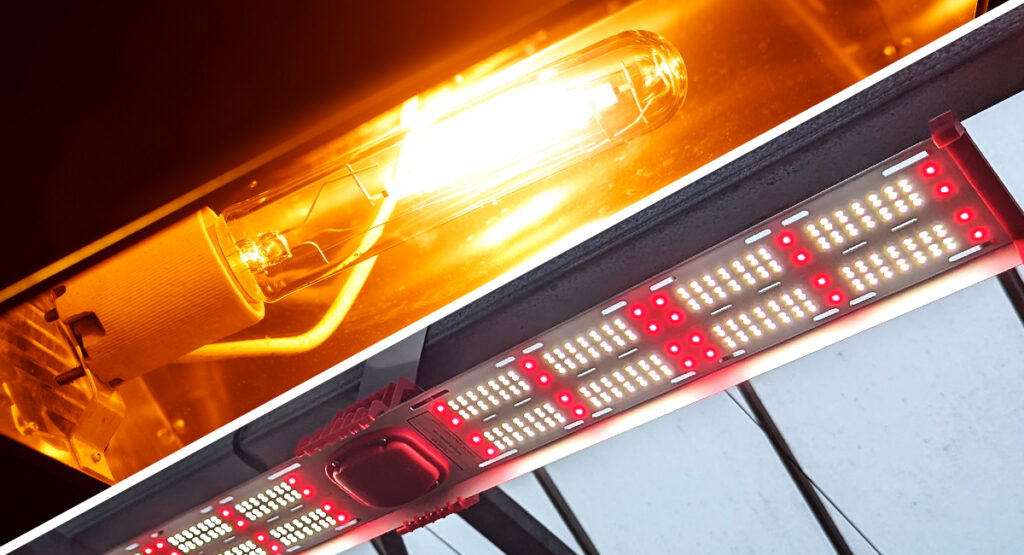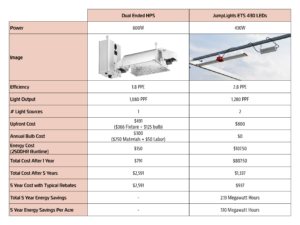
April 19, 2023
For greenhouse growers, lighting has always been a critical element within our industry. However, before the 20th century, greenhouse lighting was inefficient, unreliable, and of unknown utility. In those days, growers simply had to rely on sunlight—they were always at the mercy of mother nature—bound by geography, microclimate, and seasonality. The early introduction of artificial light sources after the turn of the century brought a significant improvement to greenhouse lighting. Simultaneous improvements in plant science and lighting equipment accelerated the pace of adoption through the turn of the millennium. Finally, as history has taught us, lighting technology and associated plant science go hand in hand: leading up to the mega-opportunity of LED greenhouse lighting and associated value to the industry.
Early 20th Century Lighting
In the early part of the 20th century, and for the first time in history, growers were unbound from the confines of available sunlight. As Garner and Allard found in 1920, extending day length for long-day plants (like petunia and Monkeyflower) can induce flowering. This meant that growers that used artificial greenhouse lights could produce flowering plants independent of their geography or season. This was a breakthrough for the industry, but running artificial lights for extended periods of time was difficult: lighting technology at that time was costly, prone to failure, and of limited quality as the typical silica glass used for the bulbs would rapidly blacken and stop transmitting light.
Advances took place in the 1930s to alleviate some of these problems. In that era in Germany, Marcello Pirani created a sodium-resistant glass that was resistant to blackening over time. He did this by using an oven, heating the lamps, and vaporizing the sodium in order to start the lamp, making it possible for the light to shine through the glass. Pirani, along with Compton, started down the path that ultimately led to the next breakthrough a few decades later. The available technology at this point was low-pressure sodium (LPS) lamps that used sodium-resistant glass for bulbs.
The 1960s
The 1960s saw huge advances in plant science as well as the development of two different lighting systems used by growers; high-pressure sodium (HPS) lights and metal halide (MH) lights. 1964 in particular was a big year:
On the plant science front, Karl Hamner, along with Murray Coulter and Bruce Carpenter discovered night break. Providing light pulses during the night both enabled long-day plants to flower as well as inhibited short-day plants from flowering. This meant that lights would only have to be used for a fraction of the time for these purposes. Not only was light technology about to get much better but the runtime could be optimized to save even more energy while getting desired results.
In that same year, on the lighting development side, William Louden, Kurt Schmidt, and Elmer Homonnay invented the first HPS lamp utilizing an arc tube. They placed electrodes capable of withstanding the pressure and temperatures, along with the corrosive nature of sodium that had been used previously.
HPS lights give off an amber-colored hue, which is considered to be a better color rendering than what the old LPS lamps would produce. This new HPS lighting technology was far more efficient, bright, had better CRI, and lasted longer than the old LPS lights. This technology rapidly made its way to the greenhouse world and would prove to be the dominant technology up until today.
HPS light benefits Compared to Low-Pressure Sodium (LPS):
- Better efficiency
- Smaller
- Longer bulb lifespan
A typical HPS light provides1:
- CRI 20–30
- 80–140 Lumens per Watt
- Bulb lifespan: 24,000
Early HPS lights only used about 50–400 watts of power and had an efficacy of less than 1 PPE. At that time, this type of light was primarily used for supplemental lighting in greenhouses to night break and to slightly increase DLI.
As the decades of innovation progressed this technology, growers and manufacturers pushed the industry in 3 main ways. The first was an increase in power, ranging from approximately 600W in the 1990s to 1,000W in the 2000s. Next was the efficiency, or photometric efficacy PPE, which went from sub 1 levels to eventually reaching a 1.6-1.8 PPE for dual ended (DE) HPS. Finally, the spectrum shifted to the right, moving from a yellow centric spectrum to an amber-centric spectrum.
These updates to the lighting technology and the understanding of lights’ utility drove the adoption of billions of dollars’ worth of lighting installs in greenhouses all over the world. The market and technology for HPS is now mature. It has reached an upward limit on efficiency of less than 2 PPE and a lower limit on cost in the $300-$600 range for high-powered lights.
LED’s Bright New Future
Even though HPS has had much success in greenhouses for the past 60 years, there are still some things that the technology just can’t do—leaving a massive opportunity for LED lights.
- Spectrum. Sodium vapor emits light in a given spectrum and it is what it is, no matter which plant type you’re growing or what stage of growth it’s in. With LEDs, there are many choices. Blue-heavy spectra are ideal for young plants or bedding plants, while red-heavy spectra provide high power and high efficiency. LEDs can also go outside of the visible spectrum if necessary.
- Form factor. Compared to designs that can be made with LEDs, HPS are big, heavy, hot, and have limited point sources of light. LED advantages are that they run cooler so they can be placed closer to plants (like our catalyst light) and they can emit light from multiple point sources (like our ETS 430).
- Efficiency. HPS has reached its limit on efficiency whereas LEDs are still hitting their stride. Just a few years ago, the divide wasn’t as great: a really good new HPS that hadn’t degraded light intensity could get around 1.8 PPE and LEDs were in the low 2s. These days LEDs can hit up to 3.6 PPE, getting twice as many photosynthetically active photons per watt than a good HPS light can.
- Control. With LED lights, dimming is much more precise and built into all DLC listed Horticultural luminaires, HPS just doesn’t work as well for dimming. Combining both the dimming capability of LEDs with the wide spectrum options, growers may be able to have fully controllable systems soon.
- Longevity. L90—the lifetime of a light when the output is 90% of what it was originally—is much longer for LEDs than for HPS. In most cases, it’s about 5 times as long or more.
It’s obvious that there are many advantages to LEDs, but what about upfront cost? This is where some growers get hung up. One of the first things to do when considering an LED install is to check for rebates from your utility company or their rebate provider. If you need assistance, please contact us. Another thing to do is consider the economics of increasing yield and reliability combined with reduced maintenance and electricity costs.

JumpLights has been fortunate enough to come in right at the perfect moment where LEDs are high-volume, with a lower cost, and have great longevity. We’ve designed our lights to be solid, simple, and efficient (from 2.8 PPE to 3.6 PPE). For example, one of our 430W lights can run close to 1,200 PPF for young plants. An equivalent metal halide (used for young plants) would only put out 540 PPF! Our lights put out much more light per watt and have a fine-tuned spectrum, which can be chosen by the grower depending on which types of plants they want to cultivate. They’re future-proof as well, our lights have a long lifespan and can work in conjunction with our future narrow-band spectrum lights and high-tech controllers.
Do you want to learn about the right type of lighting solutions for all the plants you’re growing? Contact us today!
Sources:
1https://edisontechcenter.org/SodiumLamps.html




